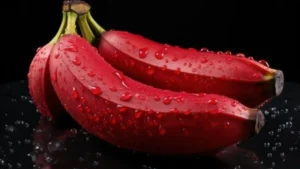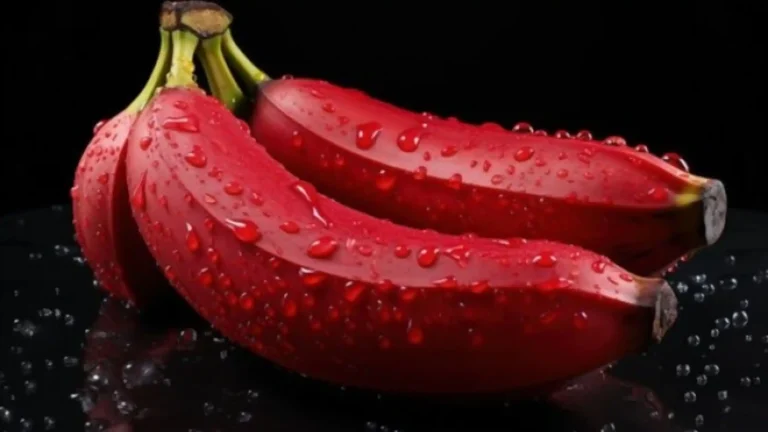What is Unique About Red Bananas?
Red bananas are a unique and intriguing variety of the common banana, known for their distinctive reddish-purple skin and slightly sweeter taste compared to yellow bananas. They are smaller and plumper, with a flesh that can range from cream to light pink. Red bananas offer a variety of health benefits and culinary uses, making them an excellent addition to your diet.

Different Types of Bananas
Bananas are a diverse fruit with several varieties, each with its own characteristics:
- Cavendish Bananas: The most common type found in supermarkets. They are yellow when ripe and have a soft, sweet flavor.
- Plantains: Larger and starchier, plantains are often used in cooking rather than eaten raw.
- Red Bananas: Smaller with reddish-purple skin, these bananas are sweeter and creamier.
- Burro Bananas: Squat and square-shaped with a lemony tang, these bananas are good for both cooking and eating raw.
- Blue Java (Ice Cream Bananas): Known for their blue skin and creamy texture, these bananas have a flavor reminiscent of vanilla ice cream.
- Manzano Bananas: Also known as apple bananas, they are shorter, plumper, and have a taste similar to apples or strawberries when ripe.
Should I Be Concerned if the Inside of My Banana Had a Small Red Spot?
Finding a small red spot inside your banana can be alarming, but it is usually harmless. These spots are often caused by bruising or minor fungal infections. While they might affect the banana’s appearance, they typically do not pose a health risk. However, if the spot is accompanied by a foul smell or significant discoloration, it’s best to discard the banana.
What Do Red Bananas Look Like?
Red bananas are visually striking with their reddish-purple skin. They are shorter and thicker than the common yellow Cavendish banana. When ripe, their skin darkens, and the flesh inside becomes cream to light pink in color. They are known for their sweet and slightly raspberry-like flavor, making them a delicious and exotic fruit choice.
Do You Know About the Benefits of Red Bananas?
Red bananas are not only unique in appearance but also packed with nutritional benefits:
- Rich in Nutrients: Red bananas are an excellent source of vitamins C and B6, potassium, and fiber. These nutrients support overall health, boost the immune system, and aid in digestion.
- Antioxidant Properties: They contain beta-carotene and lutein, which help protect against cell damage and support eye health.
- Boosts Immune System: The high vitamin C content in red bananas can help strengthen the immune system, reducing the risk of illnesses.
- Promotes Healthy Skin: The antioxidants and vitamins in red bananas contribute to healthy, glowing skin.
- Energy Boosting: Like all bananas, red bananas are rich in natural sugars, making them a quick and healthy energy source.
Are Red Bananas Naturally Red?
Yes, red bananas are naturally red. Their distinctive color comes from the presence of anthocyanins, which are powerful antioxidants also found in other red and purple fruits and vegetables. These compounds not only give red bananas their unique hue but also contribute to their health benefits.
Pros and Cons of Red Banana
Pros:
- Nutrient-Rich: Packed with vitamins, minerals, and antioxidants.
- Unique Flavor: Sweet, creamy, and slightly raspberry-like, making them a tasty alternative to regular bananas.
- Health Benefits: Supports immune health, aids digestion, promotes skin health, and provides an energy boost.
- Culinary Versatility: Can be eaten raw, added to smoothies, or used in baking and desserts.
- Natural Color: Their red skin and flesh add visual appeal to dishes and are an indicator of their antioxidant content.
Cons:
- Availability: Red bananas are less common than yellow bananas and may not be available in all supermarkets.
- Cost: They can be more expensive due to their rarity and the costs associated with importing them.
- Ripening: They may be more prone to over-ripening, leading to a shorter shelf life compared to other banana varieties.
- Taste Preference: While many enjoy their unique flavor, it may not appeal to everyone, particularly those who prefer the taste of traditional bananas.
7 FAQs About Red Bananas
- What do red bananas taste like? Red bananas have a sweet, creamy flavor with hints of raspberry or tropical fruit, which sets them apart from the standard yellow banana.
- Where can I buy red bananas? Red bananas can be found in specialty grocery stores, health food stores, and some larger supermarkets. They are also available through online fruit vendors.
- How do I know when red bananas are ripe? Red bananas are ripe when their skin turns deep red or maroon and they feel slightly soft to the touch. Avoid bananas with overly dark or mushy spots.
- Can I use red banana in cooking? Yes, red banana are versatile in the kitchen. They can be used in smoothies, baked goods, fruit salads, or simply eaten raw as a snack.
- Are red bananas genetically modified? No, red bananas are not genetically modified. They are a naturally occurring variety that has been cultivated for centuries.
- Can you eat Red Abyssinian banana? Yes, you can eat the fruit of the Red Abyssinian banana plant, but it’s not very tasty or commonly eaten. Unlike regular bananas, the fruit of this plant is full of seeds and doesn’t have much flavor. People usually grow the Red Abyssinian banana for its beautiful red leaves and decorative look, not for eating. If you’re looking for bananas to eat, you’re better off with the common types like the Cavendish banana. Always double-check if a plant or its fruit is safe to eat before trying it!
- How to care for a Red Abyssinian banana plant?Caring for a Red Abyssinian banana plant is pretty straightforward! Here’s how to keep it happy:
- Light: It loves plenty of sunlight. Place it in a spot where it gets full sun to partial shade.
- Water: Keep the soil consistently moist but not soggy. Water it regularly, especially during hot weather, but make sure the soil drains well to avoid root rot.
- Soil: Use rich, well-draining soil. Adding compost or organic matter can help it grow better.
- Temperature: This plant thrives in warm climates and doesn’t like cold. If you live in a cooler area, consider growing it in a pot so you can bring it indoors during winter.
- Fertilizer: Feed it with a balanced fertilizer every 4-6 weeks during the growing season (spring and summer) to encourage healthy growth.
- Pruning: Remove dead or damaged leaves to keep the plant looking neat and to prevent pests or diseases.
- Pests: Watch out for common pests like aphids or spider mites. If you spot any, treat the plant with insecticidal soap or neem oil.
With proper care, your Red Abyssinian banana plant will grow into a stunning, eye-catching addition to your garden!
In conclusion, red bananas are a fascinating and nutritious fruit worth exploring. Their unique appearance, health benefits, and versatile uses make them an excellent addition to any diet. Whether you’re curious about their taste or looking for a new way to boost your nutrient intake, red bananas offer something special for everyone.
Thank you for reading our comprehensive guide to Discover the 7 Best serum for Glowing Skin and its regional variations! We hope you found valuable insights into it.
If you’re interested in exploring more about healthy eating and lifestyle tips, feel free to check out our latest blog on Papaya Seeds Benefit
Stay tuned for more informative content and don’t forget to subscribe to our newsletter for updates on future articles.
